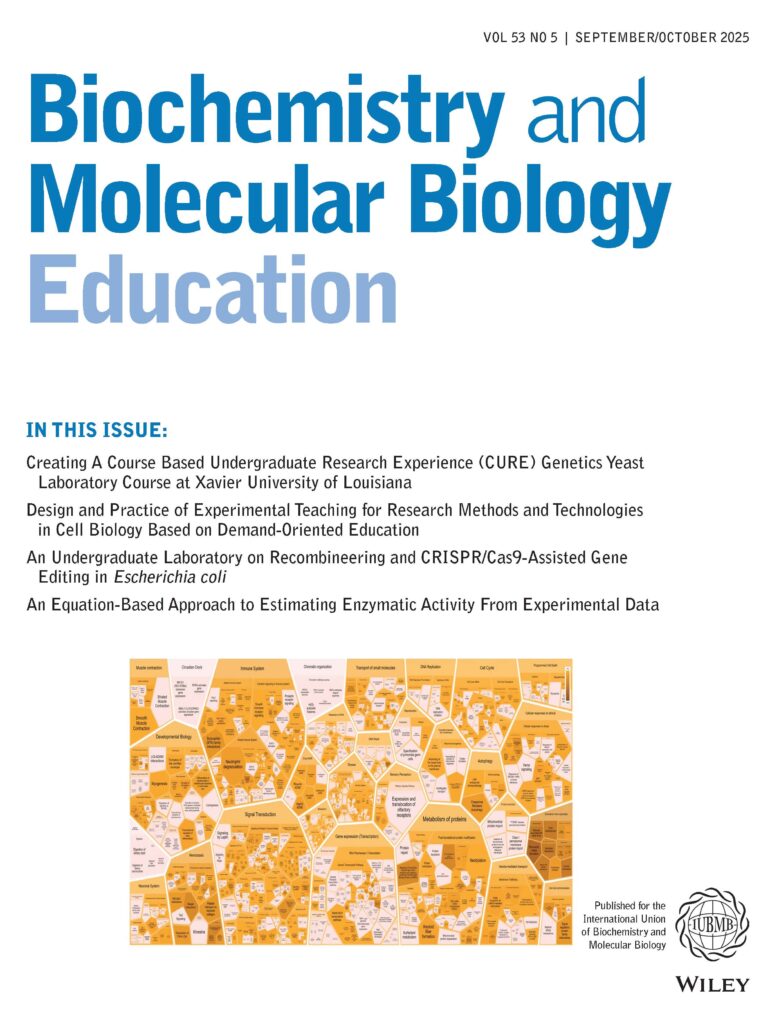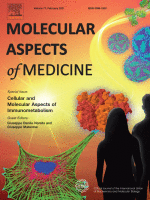

We are excited to highlight new research from the IUBMB Journals: IUBMB Life, BioFactors, Biotechnology and Applied Biochemistry, and Biochemistry and Molecular Biology Education.
Please also consider submitting your own research to the IUBMB Journals. You can expect to work with distinguished Editorial Board members and benefit from worldwide circulation and readership through our publishing partnership with Wiley. For more information about the journal and submissions, feel free to peruse the IUBMB journals website.
For now, please enjoy highlights of our recent content. Happy reading!
IUBMB Life
New Issue: Volume 77, Issue 9

Issue Highlights (Subscription Only)
Y. Chen, Y. Guo, A. Hu, et al., “Pan-Cancer Analysis Identifies DIP2B as a Potential Biomarker That Inhibits Kidney Renal Clear Cell Carcinoma Progression,” IUBMB Life 77, no. 9 (2025): e70046.
Disco interacting protein 2 homolog B (DIP2B) is involved in embryonic development, cell cycle regulation, and DNA repair, but its role in cancer is unclear. We analyzed DIP2B expression, molecular functions, and clinical significance across cancers using TCGA, GTEx, and UALCAN datasets. High DIP2B expression correlated with poor overall survival in BRCA, KICH, LUAD, MESO, SARC, and THCA, but with improved outcomes in KIRC. For disease-specific survival, elevated levels predicted adverse outcomes in ACC, MESO, and UVM. Functional analyses linked DIP2B to cytoskeleton organization, MAPK signaling, and protein catabolism. Experimental validation showed DIP2B knockdown reduced proliferation and migration in KIRC, while acting oncogenically in LUAD. These results suggest DIP2B as a potential biomarker with context-dependent roles, including a tumor-suppressive effect in KIRC.
Exploring Macrophage Contribution to Vascular Calcification in Atherosclerosis
S. A. Dabravolski, M. A. Popov, O. N. Maltseva, V. V. Pavshintsev, A. S. Utkina, and A. N. Orekhov, “Exploring Macrophage Contribution to Vascular Calcification in Atherosclerosis,” IUBMB Life 77, no. 9 (2025): e70064.
Vascular calcification (VC) is a significant pathological feature of atherosclerosis, contributing to cardiovascular morbidity and mortality, particularly in populations with diabetes and chronic kidney disease (CKD). This review examines the pivotal role of macrophages in the development and progression of VC within atherosclerotic plaques. The authors explore the diverse phenotypes of macrophages, particularly the pro-inflammatory M1 and anti-inflammatory M2 types, and their distinct functions in modulating vascular smooth muscle cell (VSMC) behavior. By elucidating the cellular and molecular mechanisms underpinning macrophage-mediated calcification, this review aims to provide insights into the dual roles of macrophages in atherosclerosis and their significance as potential therapeutic targets. Understanding these dynamics may lead to innovative strategies for preventing VC and improving cardiovascular health outcomes, particularly in patients with diabetes and CKD.
—
SPECIAL ISSUES OPEN FOR SUBMISSION
- The Role of Human Gut Microbiota in Health and Disease
- Deadline for Submissions: 31 July 2025
CALL FOR PAPERS – SPECIAL ISSUES PROPOSALS
IUBMB Life solicits proposals for special issues relevant to the mission of our journal in the field of Biochemistry, Molecular Biology, Cell Biology, Structural Biology and Molecular Medicine and pertinent areas. This is an open call for Special Issue Proposals, and all submissions will be reviewed in a timely manner. We will provide streamlined editorial support and assistance to the special issue guest editors.
Application Process
Prospective guest editor(s) need to complete the Special Issue Proposal Form available online and submit it to adaragshet@wiley.com, together with the CV(s) of the proposed guest editor(s). Please state “IUBMB – SI proposal submission” in the subject line of your submission email.
A special issue proposal should include the following content:
- A short title that can clearly describe the scope of special issue;
- A short introduction about the significance of the special issue;
- Basic information and CV of Lead Guest Editor and Co-Guest Editors;
- List of potential authors and their tentative article titles;
- The estimated number of submissions;
- Proposed timeline.
Please visit the journal homepage for more information.
BioFactors
New Issue: Volume 51, Issue 5

Issue Highlights (Subscription Only)
M. Y. Zamanian, L. G. Khachatryan, M. Heidari, et al., “The Therapeutic Potential of Flavonols in Alzheimer’s Disease: Inhibiting Amyloid-β, Oxidative Stress, and Neuroinflammation,” BioFactors 51, no. 5 (2025): e70047.
Alzheimer’s disease (AD), marked by amyloid-β (Aβ) aggregation, oxidative stress, and neuroinflammation, remains a major health challenge. This study evaluates the therapeutic potential of flavonols—quercetin, kaempferol, myricetin, and fisetin—in mitigating AD pathology. Flavonols inhibited Aβ oligomerization and fibril formation, reduced oxidative stress via Nrf2/HO-1 activation, and suppressed neuroinflammation by modulating microglia. They also improved mitochondrial function, promoted autophagy, and regulated secretases toward non-amyloidogenic pathways. Mechanistic insights revealed quercetin enhanced synaptic plasticity, kaempferol prevented apoptosis and inhibited acetylcholinesterase, myricetin protected mitochondria and showed improved delivery with lipid carriers, and fisetin reduced Aβ burden and restored synaptic proteins. Collectively, flavonols show multi-targeted neuroprotective effects and hold promise as safe, natural candidates for AD therapy.
Q. Luo, Q. Zhang, Z. Zheng, and X. Jiang, “Knocking Down SKA1 Inhibits Hepatocellular Carcinoma Progression via Apoptosis: Integrating Single-Cell Transcriptomics With In Vivo and In Vitro Validation,” BioFactors 51, no. 5 (2025): e70044.
Hepatocellular carcinoma (HCC) is the most common type of primary liver cancer. Spindle- and kinetochore-associated complex 1 (SKA1) participates in the regulation of mitosis, playing an essential role in regulating cancer progression. Therefore, this study aims to explore the effects of knocking down SKA1 on HCC.
—
CALL FOR PAPERS
- Unlocking the Secrets of Lipocalins: Navigating Their Role in Cell Communication and Signalling
- Submission deadline: Thursday, 31 December 2025
- The Role of Human Gut Microbiota in Health and Disease
- Submission deadline: Tuesday, 31 May 2026
CALL FOR SPECIAL ISSUE PROPOSALS
BioFactors solicits proposals for special issues relevant to the mission of our journal in the field of biological factors and pertinent areas. This is an open call for Special Issue Proposals, and all submissions will be reviewed in a timely manner. We will provide streamlined editorial support and assistance to the special issue guest editors.
Application Process
Prospective guest editor(s) need to complete the Special Issue Proposal Form (downloadable from the BioFactors’ homepage) and submit it to adaragshet@wiley.com, together with the CV(s) of the proposed guest editor(s). Please state “BIOF – SI proposal submission” in the subject line of your submission email.
A special issue proposal should include the following content:
- A short title that can clearly describe the scope of special issue.
- A short introduction about the significance of the special issue.
- Basic information and CV of Lead Guest Editor and Co-Guest Editors.
- List of potential authors and their tentative article titles.
- The estimated number of submissions.
- Proposed timeline.
Please visit the journal homepage for more information.
Biotechnology and Applied Biochemistry
New Issue: Volume 72, Issue 4

Issue Highlights (Subscription Only)
Alamelu, S., Venkatesan, K.B., Srinivasan, M.K. and Pachaiappan, P. (2025), “Synthesis and Characterization of Brucine Gold Nanoparticles for Targeted Breast Cancer Therapy: Mechanistic Insights into Apoptosis and Antioxidant Disruption in MCF-7 Cells,” Biotechnol Appl Biochem., 72: 1028- 1044.
Breast cancer remains the leading cancer in women worldwide, emphasizing the need for affordable and effective therapies. This study reports the synthesis and characterization of brucine-gold nanoparticles (BRU-AuNPs) as a targeted treatment for breast cancer. BRU-AuNPs were confirmed by UV–Vis, FTIR, SEM, XRD, DLS, and zeta potential analyses, showing an average crystal size of 85.40 nm and stable surface charge. In vitro studies with MCF-7 cells revealed dose-dependent cytotoxicity (IC50: 11.47 µg/mL), increased ROS generation, mitochondrial depolarization, apoptosis induction, and inhibition of cell migration. BRU-AuNPs also upregulated pro-apoptotic gene expression. These findings highlight BRU-AuNPs as a promising targeted delivery system with potential to improve breast cancer therapy and reduce side effects.
Assessment of Garbage Enzyme as a Bioremediation Method for the Wastewater Treatment
Singh, A.N., Ray, M.R., Mishra, U., Jethwa, K.B., Yadav, N., Shankhwar, N., Chauhan, G.S. and Meshram, K. (2025), “Assessment of Garbage Enzyme as a Bioremediation Method for the Wastewater Treatment,” Biotechnol Appl Biochem., 72: 1045-1055.
This study investigates the efficacy of garbage enzyme (GE), prepared from brown sugar, fruit and vegetable waste, and water (1:3:10), in reducing sewage pollution in Jaunpur district, Uttar Pradesh, India. Sewage samples treated with varying GE concentrations (0–20%) were monitored for pH, DO, TSS, TDS, BOD, COD, and temperature over 20 days. At 20% GE, reductions of 80.6% (BOD), 62.9% (COD), 74.3% (TSS), and 43.9% (TDS) were recorded, alongside a 67.8% increase in DO. Enzymatic activity (protease, amylase, lipase) facilitated pollutant breakdown, while odor reduction was also observed. Findings highlight GE’s strong bioremediation potential for sewage treatment and natural water conservation, with further studies needed at higher dosages.
Biochemistry and Molecular Biology Education
New Issue: Volume 53, Issue 5

Issue Highlights (Open Access)
J. E. Haye-Bertolozzi, C. B. DeFreece, C. Bolden, K. Daveron, and H. Biliran, “Creating A Course Based Undergraduate Research Experience (CURE) Genetics Yeast Laboratory Course at Xavier University of Louisiana,” Biochemistry and Molecular Biology Education 53, no. 5 (2025): 478– 488.
Course-based undergraduate research experiences (CUREs) are important for providing undergraduates with authentic research experiences. At Xavier University of Louisiana, a Genetics Laboratory CURE course was developed and implemented. The goals of developing this Genetics CURE laboratory course were: (1) to provide a large number of students the opportunity to participate in a hypothesis-driven research project, (2) to determine the effect of different Msh6 missense variants on DNA mismatch repair (MMR), and (3) to provide opportunities to develop scientific communication skills. In the first 3 years of implementation, 595 students completed the course and participated in a project of evaluating DNA MMR utilizing the model organism, Saccharomyces cerevisiae. Students analyzed previously uncharacterized MSH6 alleles and summarized their findings by drafting a report in the style of a primary research article. Additionally, students communicated their findings in PowerPoint presentations, and some participated in poster presentations on campus. Examination of course evaluations indicated that students appreciated learning science theory and acquiring scientific skills in the context of a research project instead of as individual unconnected experiments.
Efficacy and Engagement With an Immersive Virtual Learning Experience of the Citric Acid Cycle
B. C. Braga, W. Hurst, J. Barrow, et al., “Efficacy and Engagement With an Immersive Virtual Learning Experience of the Citric Acid Cycle,” Biochemistry and Molecular Biology Education 53, no. 5 (2025): 500–508.
This randomized controlled trial assessed the comparative effectiveness of a biochemistry education program delivered through an immersive virtual reality (iVR) experience and traditional video-based instruction. Undergraduate students enrolled in three nutrition courses from a large R1 American university participated (n = 95). Students were randomly assigned to either an iVR condition (n = 48) or a video condition (n = 47). Students either viewed a nutritional biochemistry video or participated in an interactive iVR nutritional biochemistry experience. Nutritional biochemistry quiz scores improved, with a significant difference between the video condition and iVR condition (P = 0.05). Engagement scores were higher for the iVR (mean = 4.60) compared to the video (mean = 4.33; p = 0.02). Additionally, the total heuristic evaluation was higher for the iVR group compared with the video group (p = 0.01). Delivery of biochemistry education materials through iVR technology was shown to be more engaging than traditional video-based instruction.
Did you know? Wiley and Jisc have signed an agreement that allows UK authors to publish Open Access in the IUBMB Journals at no cost to them.
Thanks to a partnership our publisher Wiley has signed with Jisc, certain UK institutions now have full access to journals published by Wiley, including the IUBMB Journals. Further, the partnership enables authors at participating UK institutions to publish open access at no cost to them in the IUBMB Journals. Payment of the associated Article Publication Charges (APC) would be covered via the partnership, and authors will not need to cover the APCs from their own pockets.
Wiley has also signed similar agreements with universities in Germany, the Netherlands, Austria, Norway, Hungary, Finland, Sweden, and with the US-based OhioLink And VIVA. A comprehensive list of our funder agreements can be found here.
Submit your research to the IUBMB Journals today.

Molecular Aspects of Medicine

Volume 106 (December 2025) 101416
Antisense oligonucleotides for inherited retinal diseases: a comprehensive review
Hossein D. Banadaki a, Alejandro Garanto a b 1, Rob W.J. Collin a 1
Aspects of Molecular Medicine

Volume 4 (December 2024) 100048
Plants as a source of dietary bioactives: Flavonoids and basis for their health benefits
Andrea Galatro a, Agustin Lucini Mas b c, Melisa Luquet a, Cesar G. Fraga b c d, Monica Galleano b c






 Donate now
Donate now
 International Union of Biochemistry and Molecular Biology
International Union of Biochemistry and Molecular Biology